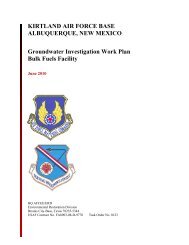Final FONSI and EA for hot cargo pad on Kirtland AFB - Kirtland Air ...
Final FONSI and EA for hot cargo pad on Kirtland AFB - Kirtland Air ...
Final FONSI and EA for hot cargo pad on Kirtland AFB - Kirtland Air ...
Create successful ePaper yourself
Turn your PDF publications into a flip-book with our unique Google optimized e-Paper software.
<str<strong>on</strong>g>Final</str<strong>on</strong>g> <str<strong>on</strong>g>EA</str<strong>on</strong>g> Addressing C<strong>on</strong>structi<strong>on</strong>, Operati<strong>on</strong>, <str<strong>on</strong>g>and</str<strong>on</strong>g> Maintenance of a Hot Cargo Pad<br />
<br />
<br />
<br />
<br />
<br />
<br />
<br />
<br />
C<strong>on</strong>trol storm water volume <str<strong>on</strong>g>and</str<strong>on</strong>g> velocity to minimize erosi<strong>on</strong><br />
C<strong>on</strong>trol storm water discharges including both peak flow rates <str<strong>on</strong>g>and</str<strong>on</strong>g> total storm water volume<br />
Minimize the amount of soil exposed during c<strong>on</strong>structi<strong>on</strong> activities<br />
Minimize the disturbance of steep slopes<br />
Minimize sediment discharges from the site using c<strong>on</strong>trols that address factors such as the<br />
amount, frequency, intensity <str<strong>on</strong>g>and</str<strong>on</strong>g> durati<strong>on</strong> of precipitati<strong>on</strong>; the nature of resulting storm water<br />
runoff; <str<strong>on</strong>g>and</str<strong>on</strong>g> soil characteristics, including the range of soil particle sizes expected to be present <strong>on</strong><br />
the site<br />
Provide <str<strong>on</strong>g>and</str<strong>on</strong>g> maintain natural buffers around surface waters, direct storm water to vegetated areas<br />
to increase sediment removal <str<strong>on</strong>g>and</str<strong>on</strong>g> maximize storm water infiltrati<strong>on</strong> where feasible<br />
Minimize erosi<strong>on</strong> at outlets <str<strong>on</strong>g>and</str<strong>on</strong>g> downstream channel <str<strong>on</strong>g>and</str<strong>on</strong>g> stream bank erosi<strong>on</strong><br />
Minimize soil compacti<strong>on</strong> <str<strong>on</strong>g>and</str<strong>on</strong>g> preserve topsoil where feasible.<br />
In additi<strong>on</strong>, c<strong>on</strong>structi<strong>on</strong> site owners <str<strong>on</strong>g>and</str<strong>on</strong>g> operators that disturb <strong>on</strong>e or more acres of l<str<strong>on</strong>g>and</str<strong>on</strong>g> are required to<br />
use BMPs to ensure that soil disturbed during c<strong>on</strong>structi<strong>on</strong> activities does not pollute nearby water bodies.<br />
Effective August 1, 2011, c<strong>on</strong>structi<strong>on</strong> activities disturbing a total of 20 or more acres at <strong>on</strong>e time,<br />
including n<strong>on</strong>-c<strong>on</strong>tiguous l<str<strong>on</strong>g>and</str<strong>on</strong>g> disturbances that take place at the same time <str<strong>on</strong>g>and</str<strong>on</strong>g> are part of a larger<br />
comm<strong>on</strong> plan of development, must comply with the numeric effluent limitati<strong>on</strong> <str<strong>on</strong>g>for</str<strong>on</strong>g> turbidity in additi<strong>on</strong><br />
to the n<strong>on</strong>-numeric effluent limitati<strong>on</strong>s. The maximum daily turbidity limitati<strong>on</strong> will be<br />
280 nephelometric turbidity units.<br />
Secti<strong>on</strong> 438 of the Energy Independence <str<strong>on</strong>g>and</str<strong>on</strong>g> Security Act (EISA) (42 U.S.C. 17094) establishes into law<br />
new storm water design requirements <str<strong>on</strong>g>for</str<strong>on</strong>g> Federal c<strong>on</strong>structi<strong>on</strong> projects that disturb a footprint of greater<br />
than 5,000 square feet of l<str<strong>on</strong>g>and</str<strong>on</strong>g>. EISA Secti<strong>on</strong> 438 requirements are independent of storm water<br />
requirements under the CWA. The project footprint c<strong>on</strong>sists of all horiz<strong>on</strong>tal hard surfaces <str<strong>on</strong>g>and</str<strong>on</strong>g> disturbed<br />
areas associated with project development. Under these requirements, predevelopment site hydrology<br />
must be maintained or restored to the maximum extent technically feasible with respect to temperature,<br />
rate, volume, <str<strong>on</strong>g>and</str<strong>on</strong>g> durati<strong>on</strong> of flow. Predevelopment hydrology shall be modeled or calculated using<br />
recognized tools <str<strong>on</strong>g>and</str<strong>on</strong>g> must include site-specific factors such as soil type, ground cover, <str<strong>on</strong>g>and</str<strong>on</strong>g> ground slope.<br />
Site design shall incorporate storm water retenti<strong>on</strong> <str<strong>on</strong>g>and</str<strong>on</strong>g> reuse technologies such as bioretenti<strong>on</strong> areas,<br />
permeable pavements, cisterns/recycling, <str<strong>on</strong>g>and</str<strong>on</strong>g> green roofs to the maximum extent technically feasible.<br />
Post-c<strong>on</strong>structi<strong>on</strong> analyses shall be c<strong>on</strong>ducted to evaluate the effectiveness of the as-built storm water<br />
reducti<strong>on</strong> features. As stated in a DOD memor<str<strong>on</strong>g>and</str<strong>on</strong>g>um dated January 19, 2010, these regulati<strong>on</strong>s will be<br />
incorporated into applicable DOD Unified Facilities Criteria (UFC) within 6 m<strong>on</strong>ths (DOD 2010).<br />
Additi<strong>on</strong>al guidance is provided in the USEPA’s Technical Guidance <strong>on</strong> Implementing the Stormwater<br />
Runoff Requirements <str<strong>on</strong>g>for</str<strong>on</strong>g> Federal Projects under Secti<strong>on</strong> 438 of the Energy Independence <str<strong>on</strong>g>and</str<strong>on</strong>g> Security<br />
Act.<br />
Floodplains are areas of low-level ground present al<strong>on</strong>g rivers, stream channels, or coastal waters that are<br />
subject to periodic or infrequent inundati<strong>on</strong> due to rain or melting snow. Floodplain ecosystem functi<strong>on</strong>s<br />
include natural moderati<strong>on</strong> of floods, flood storage <str<strong>on</strong>g>and</str<strong>on</strong>g> c<strong>on</strong>veyance, groundwater recharge, nutrient<br />
cycling, water quality maintenance, <str<strong>on</strong>g>and</str<strong>on</strong>g> habitat <str<strong>on</strong>g>for</str<strong>on</strong>g> a diversity of plants <str<strong>on</strong>g>and</str<strong>on</strong>g> animals. Flood potential is<br />
evaluated by the Federal Emergency Management Agency (FEMA), which defines the 100-year<br />
floodplain as an area within which there is a 1 percent chance of inundati<strong>on</strong> by a flood event in a given<br />
year. Risk of flooding is influenced by local topography, the frequency of precipitati<strong>on</strong> events, the size of<br />
the watershed above the floodplain, <str<strong>on</strong>g>and</str<strong>on</strong>g> upstream development. Federal, state, <str<strong>on</strong>g>and</str<strong>on</strong>g> local regulati<strong>on</strong>s often<br />
Kirtl<str<strong>on</strong>g>and</str<strong>on</strong>g> <strong>AFB</strong>, NM January 2011<br />
3-18
















